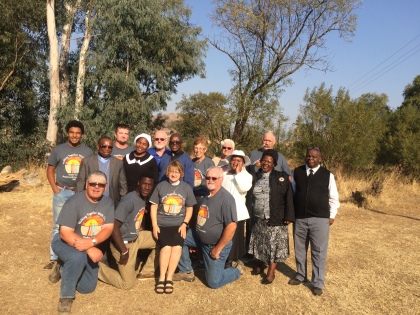This has been a wild spring! First we had lots of snow that didn’t go away, then we had rain that would not quit.
Normally we want to start planting corn about April 23, but it was still cold and wet then. I did finally get started planting on the 7th of May, but I only got 1 acre planted that day. It wasn’t until the 18th of May that I finally got finished planting corn, a full 8 days later than our usual end of planting date.
I got right at it and started planting soybeans on the 20th of May, but then the skies opened up. The field I started to plant got over 4 inch of rainfall that night, and since it is near a creek, all of our neighbors water ran across that field. It was not until the 5th of June before I could get back into that field.
Several times I tried to get soybean planting going again, but it was not until June first that I finally got another field planted. The first week of June stayed mostly dry and I got all of the soybeans planted, about two weeks later than I wanted, but planted.
Between June 6 and June 11 we got 1.3 inches of rain, then 4 days in a row of no rain. I started to get ready to kill some weeds. Then the skies opened. Between June 16 and June 21 we got 6.8 inches of rain, and we had flooded fields.
It is now June 26, 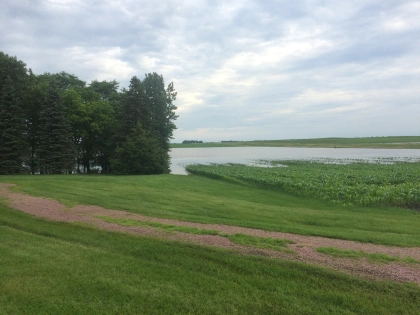 we still have water everywhere. This is north of my dad’s buildings where about 3 feet of water is not going away. We’ll lose crop here.
we still have water everywhere. This is north of my dad’s buildings where about 3 feet of water is not going away. We’ll lose crop here. 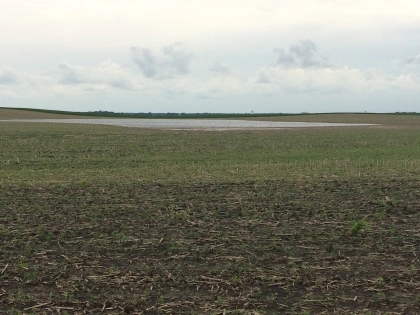 There’s a low spot in this bean field southeast of my house,
There’s a low spot in this bean field southeast of my house,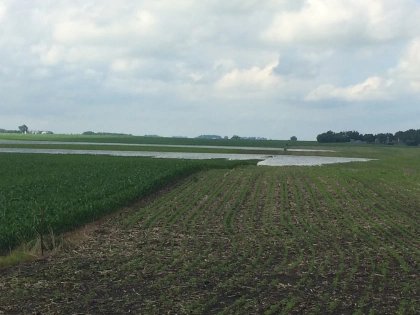 and two ponds in view along my dad’s west fence line.
and two ponds in view along my dad’s west fence line. 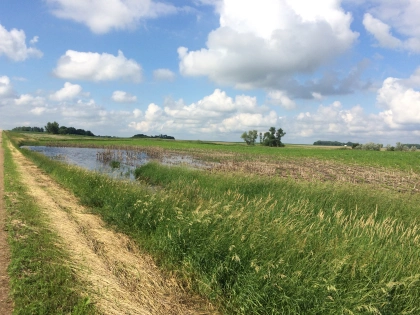 This spot was so wet last fall we could not get it harvested, it still has water in it today. I’m actually amazed that the soybeans look good here since this field got two showers of over 4 inches.
This spot was so wet last fall we could not get it harvested, it still has water in it today. I’m actually amazed that the soybeans look good here since this field got two showers of over 4 inches.
My farm has gotten 9.6 inches of rain so far this month and more is forecast in a day or two. This is definitely a spring for the record books.
Filed under: church, Kwazamohkuhle, Ondini circuit, rain, Shetek Conference, South Africa
On Wednesday, August 2, 2017, ten members of churches in the Shetek Conference of the ELCA (Evangelical Lutheran Church in America) left for the Ondini Circuit in the Kwa-Zulu Natal of South Africa. The time for our return home came all too quickly. 14 busy days were spent with the fellow Lutherans of the Ondini Circuit. When you are in the midst of it all, it seems as if the day will never come, and then we are saying goodbye.
We held our partnership meeting where we discussed what has been done, and what needs to be done, but got into very little of how to do the things that need to be done.
We took our picture with our partners. That picture is a remembrance and a reminder that these friends of ours are still there working for the betterment of their area every day.
We exchanged gifts. Ours included an original oil painting by a talented former member of my home congregation. There were also a pile of the grey “Walking Together With Christ” partnership tees, over 700 partnership pens and a multitude of other items that are needed day-to-day in a depressed area.
Our partners gave us a large platter like those used in so many ways in Africa.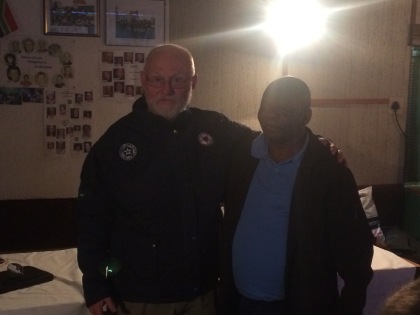
Dale got a Ondini Circuit jacket like so many we had seen on our travels.
We all got polo shirts. The shirts have the Luther Rose on the left and the Diocese emblem on the right side.
The backs of the shirts tell of the themes for each of the past church years in what they have been celebrating as the Luther Decade, all leading up to the 500th Anniversary of Martin Luther’s birth. We all had been looking at the many ways their churches celebrate membership in the wider church and were proud to be able to wear these shirts.
But now the day of departure was upon us. We woke to a light rain, that changed to just moisture in the air. The comment was made that even the sky was weeping in goodbye.
We all went to chapel that morning. We sang for the workers at the Centre and they sang for us. As usual they sang us out the door. We emerged to a rainbow in the western sky, and that brought lots of tears. We were saying good-bye to Africa.
Will I return again? Who knows, that is for the future to decide. I do know that I left a bit of my heart with the wonderful people I was lucky enough to meet in the Ondini Circuit, and that will never leave.
Filed under: Ag education, agriculture, church, food, food safety, garden, Kwazamohkuhle, Minnesota, Ondini circuit, rain, Shetek Conference, South Africa
On Wednesday, August 2, 2017, ten members of churches in the Shetek Conference of the ELCA left for the Ondini Circuit in the Kwa-Zulu Natal of South Africa. This group from Southwestern Minnesota included 5 farmers, a nurse, a food service worker, a pastor and two young men just headed off to college. For 4 of us this was a return trip, for the rest it was a new adventure.
Roughly, the Ondini Circuit includes the area from Estcourt, Muden and Weenen in the southeast to Bethlehem and Reitz in the northwest. It goes from the foothills of the Drakensberg mountains and up into the mountains. The area is rough. Valleys and level areas are separated by sharp hills in the southeast and buttes and mesas in the northwest. The best farmland is controlled by descendents of white settlers, but many areas with good potential still exist in the native, black settled areas.
Most homes in this area have access to clean water, but in some cases it may be a barrel that is filled by a water truck. Homes vary from those with every convenience we here in the U.S. expect to a steel or concrete walled structure with a steel roof. If you have a job, you have a decent home, if you do not, the living is rough.
Temperatures in the area rarely fall below freezing so homes are easy to heat with a small fire or heater in the winter. Summer temperatures are hot, but not unbearably so, the nighttime cooling easily counters the daytime heat.
This is dry country. What rain they get makes it easy to grow crops in the spring and summer, but this land can support year around agriculture, irrigation is needed to get a really dependable crop, and the area has had a three-year run of drought. Runoff from the Drakensberg mountains fills reservoirs, but not all water is impounded like it could be. Some of the water is destined for drier cities to the north and is not accessible for local use.
Our trip was mainly to visit the black churches of the Ondini circuit, to talk about health and wellness issues, pastoral support and ways to provide other support to the many who live here on government support. It is an important task that local churches have taken on, but they need help. Most expertise to run mission outposts was removed when the post Apartheid government and churches took power. It is to one of these old mission outposts that we were bound.
More posts are coming on our trip to the Ondini. Stay tuned.
Filed under: Ag education, agriculture, Corn, Fall, Farm, harvest, Minnesota, rain, weather | Tags: Corn, corn diseases, farm, rain
It’s been a wet year in our part of Minnesota. We have never been short of moisture at any time this year, in fact most of the year we have been wet. The rains come and do not turn off. Getting field work done has been hard. Now as the fall harvest is nearing, corn farmers are wondering is my corn maturing,
or dying?
Every year as harvest nears a host of rots and diseases move into our corn stalks to start the breakdown of dying corn plants. Sometime they move in too soon and the corn dies before it matures. Then you have a mess like in the second picture above. Modern corn varieties are less susceptible to many of those diseases and rots, but when too much water kills off the corn before it matures, the rot takes over.
In about a month we will be into harvest. If too much of our corn is down and rotting, we will have reduced yields and difficult harvest conditions. Then we will know the answer to our question, is that corn crop maturing or dying?
Filed under: Ag education, agriculture, birds, Farm, Farm Bureau, farm life, FarmFest, fish, food, food safety, Minnesota, Minnesota Farm Bureau, Politics, rain, science
I spent this last Wednesday at FarmFest near Redwood Falls, Minnesota. As always, there were lots of displays and things for sale, but I always take time for some of the forums on current issues.  The 1:15 session was titled “Buffers, WOTUS* and other Water Quality Issues.” Now when you get farmers talking water, you get all kinds of concern. We are always talking about how little or how much water we have. Water is life for both our crops and our livestock. Water is a big deal on the farm. Now if you add in government control of our water, you are likely to get fireworks. (*Waters of the United States, it refers to a bill that could increase government control of water way beyond what is reasonable.)
The 1:15 session was titled “Buffers, WOTUS* and other Water Quality Issues.” Now when you get farmers talking water, you get all kinds of concern. We are always talking about how little or how much water we have. Water is life for both our crops and our livestock. Water is a big deal on the farm. Now if you add in government control of our water, you are likely to get fireworks. (*Waters of the United States, it refers to a bill that could increase government control of water way beyond what is reasonable.)
The forum brought together nine speakers from various backgrounds, mainly commodity and farm group leaders, plus the local legislator (who wrote the “Buffer” bill) and an assistant to the state secretary of Agriculture. So here are a few nuggets of wisdom and some comments on water issues from the forum.
“We all want water quality, we just want someone else to pay for it.” Now isn’t that the truth. But who should pay for it. Well it boils down to blaming the least vocal, least politically connected voices, lately that seems to be farmers.
“Currently in Minnesota about 80% of the waters that need a buffer already have one.” That was a revelation. When the governor started pushing for buffers along all the waters in Minnesota you would have thought we had a real problem, but most of the job is already done. But the next one really did open my eyes.
“In many cases, waters that do not have a buffer, need something other than a buffer to protect water quality.” Now isn’t that interesting. So again we have politicians pushing for something that is only needed in a small number of cases and they end up creating a big fuss when the job is almost already done.
“There are no waters in the state of Minnesota that are clean enough to drink risk free, and have most like never have been.” Now I’ve been canoeing in the “pristine” waters of the Boundary Waters Canoe Area, and I know that even there you deal with fish, mammal and bird poop in the water and the bacteria they have that can cause distress in humans. That is a remote area, in areas more densely populated and warmer that density of potential problems increases. Waters that contain fish, entertain birds and have swimming and wading mammals, amphibians and reptiles will always contain risks for disease transmission, this is not new.
Groups that regulate farmers seem to be seeking out ways that they can push for multi-million dollar fines for doing activities that are not even in their rules to control. Normal farming activities that are up to date and environmentally friendly to most are being levied with suits to see if the regulation will stick. If farmers cave in, it becomes law. “They want to face individual farmers, not farm groups. If we contact our farm group we can combat these illegal taking of farm activities.” As a group we can face up to those who wish to push the law too far. The courts have been on our side, but one farmer cannot afford all of the costs of lawyers, that is where your commodity or farm group can help. Do not suffer alone.
Now the comments turn more hopeful.
“The changes in U.S. Agriculture since the passing of the Clean Water Act in 1972 have allowed agriculture to have a smaller environmental footprint.” Farmers get all kinds of bad press when they get bigger and increase the density of their endeavors, but the truth is once we get bigger we get more concerned about controlling all of the possible elements on the farm. Two issues from our own farm.
1) When we raised pigs outdoors, pens were not designed to control manure runoff. It was spread on fields at anytime of year with no concern for whether it may end up in a stream or lake. Now every bit of manure is controlled and used as the precious resource it is.
2) Newer machines have allowed us to control crop chemicals in ways we never could before. Now we can control our crop chemicals down to the fraction of an ounce. This means using only enough, never too much of that expensive crop input.
“Water quality is improving in Minnesota, but as more obvious point sources of pollution are eliminated (factories and city sewage systems) the search for the next point of pollution goes to more and more diffused sources.” In other words, we have already done the large part of cleaning up our act, if anti-pollution groups are to keep their funding they must find more places to put the blame that may not amount to much in the overall picture.
“Farm groups are being asked ‘Are we sustainable.’ Well, yes we are. We have over 40 years of work on being sustainable. We are not yet done on improving on our sustainability. We now produce more food on less acres and with fewer animals than 50 years ago.” We have less waste and fewer inputs for more yield than at anytime in my life, that means we are doing something right.
At times when we talk water issues and government policy, it seems as if everything is hopeless. There are too few of us and we are so small. Still if we band together, our voice can still be heard. The courts have been good to us, if we get a chance to make our case. Alone we are helpless, together we can protect this precious way of life that provides food for so much of the world.
There was a time when corn that was knee high by the 4th of July was a goal to shoot for. No more.
Today (July 6, 2016) I was out in the field and found our tallest corn already at 10 feet and still growing. It’s even starting to show a few tastles which has only happened this early two other times in my life.
Alas, not all of our corn is this tall. Spots that are sandy are starting to show the lack of rain and are still quite short. Areas that were too wet at planting are also still short and not quite the deep green of the rest of the field. Still, it’s looking beautiful out there.
Filed under: 4-H, fair, Farm Bureau, FFA, rain, weather | Tags: cottonwood county, fair, Farm Bureau, weather
It’s fair time here in Cottonwood County and we are off to a rainy start. Rainfall totals are nearing 5 inches for the week and everything is a bit messy. 4-H and FFA entries are in and Open class entries are this morning. Due to the rain I expect crop and garden entries to be light. Who wants to go out into a muddy garden or field to pick entries.
I put up the Farm Bureau booth yesterday and finishing touches will be put on this morning. I’ve got the first shift of the fair starting a 5 p.m. Come by and visit for a bit.
Fair food stands open at 10:00 this morning, if the rain slows a bit all of them should see some business. The 4-H is the only enclosed food stand so they will be doing a good business despite the rain.
At least the temperatures will be nice for livestock entries today. That is supposed to change as the rains end and temperatures rise. We could have some real fair time weather by Saturday with hot, muggy days, at least the nights will give some relief.
So come enjoy the fair. Lots of people will be there to talk to and the entries will be amazing again. The carnaval is set up on asphalt so there will be no mud there. Our grandstand is enclosed and the entertainment will again be great. Hope to see you at the fair.
Well, yesterday’s blog shows just how hard it is to predict the weather. We were forecast to get inches and got just a few tenths of rain. All of the heavy stuff moved east and south. Now it’s not as if we really needed more rain, we’re doing very well on that front, thank you. It’s just that those folks east and south of us are already under flood conditions. Oh well.
There has been a steady drip here. It’s just wet enough that being outside means you get wet. Try to wear a jacket to keep off the rain and your sweat makes you just as wet as if you had not worn a jacket. Really soggy out there.
So the moral of the story, If the weatherman says it is going to do something, it will usually do something else. What a job.
It is rare that the National Weather Service is this adamant that we are going to get wet, not only wet, but lots of water. For several days now they have us as 100% chance of getting rain starting tonight and rain for 24 hours after that. Then they tell us it could be as much as an inch and a half an hour. Yep, we are going to get wet.
That forecast means a bit more of hurry in our step. Things have to be done “now.” Since we have moved into a wet pattern “now” can be hard to do at times. Wet fields do not lend themselves to getting things done “now,” they tend to get our equipment stuck. Still the spraying did get done today, and most of the hay we had cut did get baled, so let the rain come.
There are still things to do, but they will wait. This weeks “now” is past. We’ll get going on next weeks items as soon as it dries up a bit.
Filed under: Corn, Farm, Minnesota, planting, rain, seasons, Soybeans, spring, weather | Tags: Corn, Planting, rain, Soybeans, spring, spring rains
After a below normal moisture winter and early spring, the rains have begun to come. We’ve had a little sun, a little rain, and not much for heat. Still corn is beginning to emerge and soybeans to sprout. Every time we get a dry period I see more and more fields that have been planted. We are by no means done with planting here in Southwestern Minnesota, but we are getting closer.
The lack of heat is causing some distress for the corn plants that have emerged. Long periods of cloudy wet weather leave young corn plants looking a bit yellow. Then we get a dry, warmer day or two and the corn plants get a chance to green up as they draw nutrients out of the soil.
Topsoil moisture conditions have improved greatly. Now they are almost a bit too wet when you dig down a few inches. Still the subsoil areas are dry and that keeps the water on the top moving down. I’ve even seen some recovery of small ponds and creeks as the rains continue. That is really good news.
I’m just about done with planting soybeans. I’ve been waiting for a tile repair crew to come into the last area I have to plant. That crew showed up yesterday, and today it rains. So now I wait for a bit more dry and some heat. Once the soil conditions are right I only need part of a day to finish planting. We’ll get the planting done when the weather allows.


